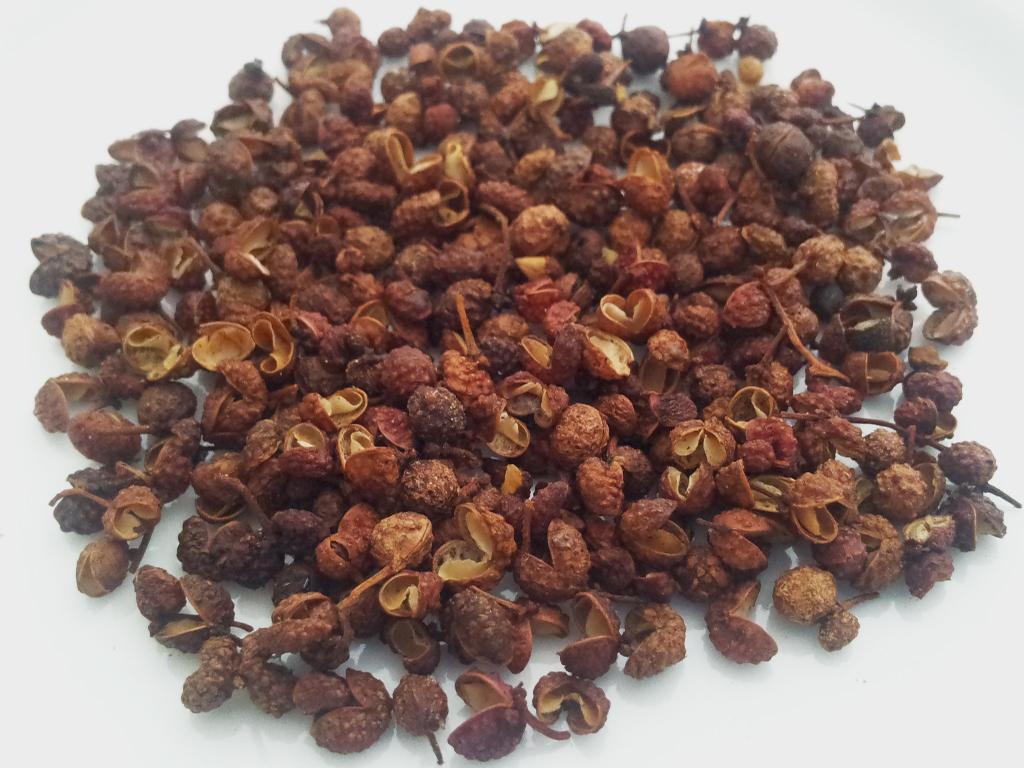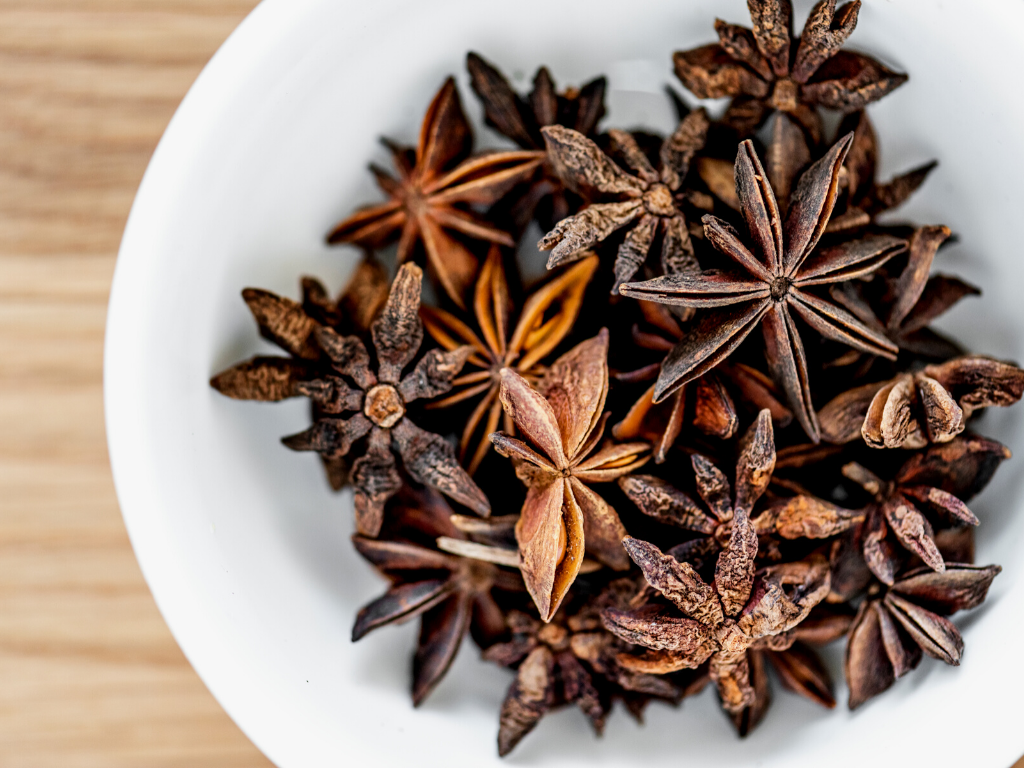7 Mins Read
Star Anise – Baat Gok
This star-shaped herb has a sweet and refreshing taste, and a strong liquorice aroma. Though not as common in the daily family diet, Cantonese people love cooking meat dishes with it- it works very well with slow roasts and stews. It is one of the main ingredients in Chinese Five Spice (see below).
High Season: October – March
How To Eat: Freshly ground star anise works very well in slow roasted meat and stew dishes. Whole star anise is a great addition to any broth- it is one of the main flavor-makers in the Vietnamese beef pho soup base.
What To Look For: Look for unbroken, whole pieces. Broken star anise will not keep as long (though is often much cheaper than the whole ones to buy).
Storage: Store in a cool, dark place away from light. Do not store near the stove or on a window sill as their volatile oils will evaporate when exposed to light, heat and even air.
Perilla/Shiso – Zi Sou
Zi Sou, or dried shiso leaf, is an herb commonly used in Traditional Chinese Medicine (TCM) as an immune booster and for curing coughs, colds and flus. Well known in its raw, fresh form to most as the ubiquitous shiso garnish on sushi platters, the plant is part of the mint family and to some, has licorice/anise like scent . Shiso occurs in both green and reddish-purple varieties.
High Season: Available all year
How To Eat: Mostly used as an ingredient in TCM formulas, the Koreans use pulverized dried shiso leaves as a seasoning in a variety of dishes. Add to homemade broth/soup if you feel a cold coming or as an additional flavoring for stir fries. Also for the more adventurous, use fresh shiso instead of basil in a (non Parmesan) pesto. We also love using the fresh leaves instead of minto for a shiso mojito.
What To Look For: Avoid dried leaves with too many bruises, brown or black marks or discoloration.
Storage: Store in airtight container in a cool, dry space.
Liquorice Root – Gam Cou
Gam Cou are dried slivers of licorice root (sometimes also called bark) that look like pieces of sliced wood and smell of, what else, licorice. It is not biologically related to anise plants even though both have a similar scent. It is an ingredient in many different TCM medicinal formulas and thought to be an important antidote to toxic substances.
High Season: Available all year
How To Eat: Include it in broths/soups for a licorice flavor or just use it to make tea- steep in boiling water and voila! Homemade infusion! Make sure to steep for at least 20 minutes to enjoy the medicinal benefits of the root such as soothing asthma lessening the effects of anxiety and helping with stomach upset. Licorice is a natural sweetener too, though the licorice flavor goes in hand in hand so it cannot be used indiscriminately as a replacement for sugar. As an alternative to mouth wash, chew on a piece of licorice root to cleanse your oral area, it works extremely well. Some green living communities use licorice root instead of tooth brushes.
What To Look For: Smell to check if still fresh- the licorice scent should be pleasantly overwhelming.
Storage: Store in a cool, dry area, away from any moisture. Keeps for up to six months.

Sichuan Peppercorn – Faa Ziu
High Season: Available all year
How To Eat: While the flavour and the effect is different, you can use Szechuan peppercorns anywhere you would use chopped chillies: ideal for adding a zing to stir-fried dishes of any kind. You can also use it as part of any meat rub blend and in place of other peppercorns- it works extremely well hand ground as a steak seasoning.
What To Look For: The most important thing to consider when buying spices is potency- so smell them when you can and go for the strongest scent. They should ideally not look too dried out either. Some moisture indicates freshness. Ideally, buy your spices whole from a reputable spice merchant. The wet market is often a much safer bet than the stale, dried spices you find in most supermarkets. Spices lose their pungency, flavour and taste fairly quickly once ground (they last max 6 months in jars) so buy them whole and grind when needed at home in a coffee grinder or high powered blender.
Storage: As above, store in a cool, dark place away from light. Do not store near the stove or on a window sill as their volatile oils will evaporate when exposed to light, heat and even air.
Chinese Parsley/Coriander/Cilantro – Jyun Sai
Chinese Parsley, known as Coriander or Cilantro across the world, is a very common herb in Cantonese cuisine- the leafy part looks quite similar to flat leaf parsley but tastes nothing like it. Its spiciness and mild bitterness make it a favourite amongst chefs.
High Season: Available all year
How To Eat: Chopped raw Chinese parsley leaves are added as flavour and scent to soups, noodle bowls, stir fries, steamed fish and much more. One of our favourite things to do is make a Chinese-style pesto with Chinese parsley, peanuts and Chinese sesame oil. The well known green dipping condiment in Indian cuisine, is an easy to make mix of Chinese Parsley, fresh mint and yoghurt.
What To Look For: Brightly coloured, whole leaves and strong stems speaks to freshness. Avoid yellowing Chinese parsley or wilted leaves- both means it is no longer in its prime.
Storage: Store with roots and stems intact in the refrigerator for up to a week. Or, if you have a bunch and can’t use it up, you can freeze the leaves flat.

Chinese Five Spice Powder – Ng Mei Fan
Chinese Five Spice Powder is a blend of ground star anise, cloves, Chinese cinnamon, Sichuan peppercorns and fennel seeds- the cinnamon and the star anise are the dominant flavours. It is the most commonly used spice blend in Cantonese cuisine, and a familiar flavour to those who enjoy its dishes. Five Spice is commonly used as a meat rub for lighter flesh like pork, chicken and duck. We wholeheartedly recommend that you blend your own Five Spice if possible!
High Season: Available all year
How To Eat: Use it to flavour any meat and poultry dishes you make, especially fatty ones- replace barbecue rubs for ribs with Five Spice or try your hand at Char Siu (Cantonese BBQ Pork), which makes great use of the blend. We like to mix it with ground meat for Asian-style burgers. For a delicious vegan Five Spice dish, add a tablespoon of thick coconut milk and 2 teaspoons of five spice to stir fried rice noodles.
What To Look For: ideally buy the freshest ground blend possible- enquire from the merchant when possible.
Storage: Buy ground spices in smaller quantities, and use up quickly. As above, store in a cool, dark place away from light. Do not store near the stove or on a window sill as their volatile oils will evaporate when exposed to light, heat and even air.
Join us next week for the Wet Market Series Part 5 where we explore the world of Chinese tofu products (Dou Fu). Or try the previous entries in this series:
Green Queen Living: Wet Market Series Part 3 – Guide to Chinese Root & Tuber Vegetables (Gan)
Green Queen Living: Wet Market Series Part 2 – Guide to Chinese Melon & Gourds (Gwaa)
Green Queen Living: Wet Market Series Part 1 – Guide to Chinese Leafy Greens (Choy)








